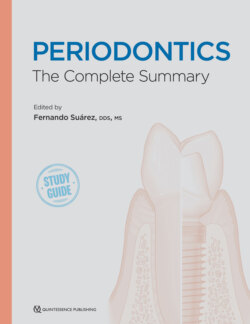Читать книгу Periodontics - Fernando Suarez - Страница 42
На сайте Литреса книга снята с продажи.
3 GINGIVITIS AND PERIODONTITIS Carlos Parra Carrasquer, DDS Fernando Suárez López del Amo, DDS, MS DEFINITIONS AND TERMINOLOGY
ОглавлениеAggressive periodontitis: A diverse group of highly destructive forms of periodontitis affecting primarily young individuals, including conditions formerly classified as “early-onset periodontitis” and “rapidly progressing periodontitis.”1
Chronic periodontitis: Forms of destructive periodontal disease that are generally characterized by slow progression.1
Epidemiology: The study of the distribution of disease or a physiologic condition in human populations and of the factors that influence this distribution.2
Gingivitis: Site-specific inflammatory condition initiated by dental biofilm accumulation and characterized by gingival redness and edema and the absence of periodontal attachment loss.3
Incidence: The frequency in which some event, such as a disease or trait, appears in a particular population or area.
Necrotizing ulcerative gingivitis: An infection characterized by gingival necrosis presenting as “punched out” papillae, with gingival bleeding and pain. Halitosis and pseudomembrane formation may be secondary diagnostic features. Fusiform bacteria, Prevotella intermedia, and spirochetes have been associated with the lesion. Predisposing factors may include stress, poor diet, smoking, and HIV infection.4
Necrotizing ulcerative periodontitis: An infection characterized by necrosis of gingival tissues, periodontal ligament, and alveolar bone. These lesions are most commonly observed in individuals with systemic conditions, including but not limited to HIV infection, malnutrition, and immunosuppression.4
Periodontal health: State free of inflammatory periodontal disease.5
Periodontitis: Chronic multifactorial inflammatory disease associated with dysbiotic plaque biofilms and characterized by progressive destruction of the tooth-supporting apparatus.1
Prevalence: The proportion of a population that has a specific characteristic at a given time.
Periodontal diseases are the result of a complex interaction between bacterial plaque, the host’s immune response, and modifying factors that may impact the course of the disease. Periodontitis in particular represents a chronic inflammatory disease typically resulting in the apical migration of the junctional epithelium along with destruction of connective tissue attachment and alveolar bone. While microbial plaque and its byproducts are the main etiologic factors initiating the disease, it is the host’s response to bacterial challenge that accounts for most of the periodontal destruction. Modifying factors such as diabetes, smoking, obesity, and genetic predisposition, among others, may exacerbate the progression of periodontal disease. Also, many of the features of periodontal disease are derived from the unique anatomy of the periodontium, in which a hard nonshedding structure (ie, a tooth) is partially embedded within the maxillary and mandibular processes.
This chapter focuses on the epidemiology, etiology, and pathogenesis, as well as the characteristics of the different forms of periodontal disease. It is important to mention that, while acknowledging the latest classification in periodontal diseases and conditions from the 2017 World Workshop (see chapter 2), several terms pertinent to previous classifications, including chronic periodontitis and aggressive periodontitis, have been used for clarification purposes.
